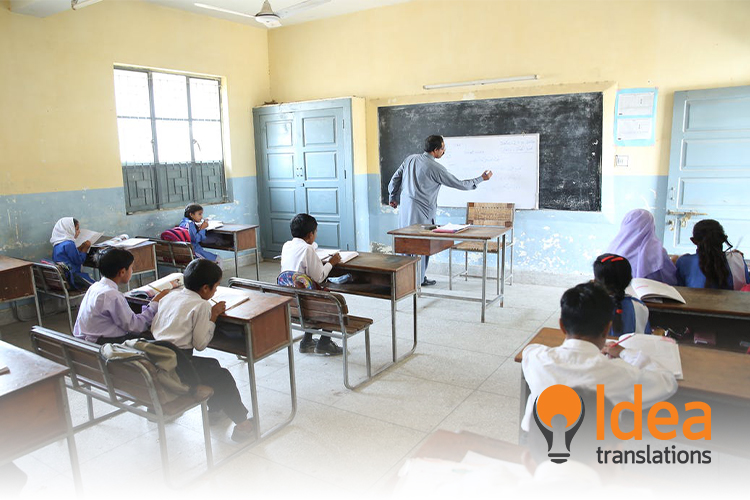
- December 29, 2021
- By: ideawebsite
- Translations, Trends
Aramaic is a semitic language that has been spoken in the Middle East since at least the 12th century BC. Inscriptions found in the last centuries were made some years before the oldest Hebrew inscriptions. Known as “the language of Jesus”, Aramaic originated in the northern region of current Syria and rapidly spread to the whole area: it was even the official Assyrian language in the 8th century BC.
Aramaic is currently used by a few speakers in Syria, Iraq, Turkey and Iran, and in some isolated regions of Australia, Europe and America. Why do some ancient and historical languages dwindle to the brink of extinction?
Endangered Languages: Risk Factors
Aramaic was key for the dissemination of the alphabetical script towards the East, using an alphabet derived from Phoenician. As it extended to different corners of the world, it gave rise to versions derived from the original language. In fact, the current Hebrew alphabet derived from the ancient Aramaic alphabet.
By the time of Alexander the Great, Aramaic was competing and alternating with Greek, which also explains the great fragmentation in smaller dialects of the “language of Jesus.” Aramaic is still used around Damascus —Syria’s capital— in villages such as Maaloula, Qamishli and Jubb’adin.
By the end of this century, almost half of the close to 7000 languages spoken today in the world may disappear.
Source: National Geographic
Nevertheless, since it was never acknowledged as an official language, it has fallen into disuse, like other thousands of languages struggling to avoid oblivion. In United States alone, more than 160 languages are endangered, many of them related to native peoples, like Chickasaw, Catawba, Chinook, Cocopah, Hupa and Kickapoo.
We have not only endangered languages, but also languages that are in a critical situation and many that are already considered extinct. Faced with this situation, experts are trying to catalog and decode vulnerable languages in order to save the cultural wealth protected by those languages. There are also organizations, such as The Endangered Languages Project, which seek to promote the documentation and revitalization of endangered languages around the world.
Only a couple hundred languages have benefited from being incorporated to educational systems and to public organizations, and less than a hundred are currently in use in the digital world. Indigenous languages are particularly vulnerable for this reason: they are not taught in schools or used in public settings.
The Constant Threat and the Importance of Fighting Back
While languages such as English, Chinese and Spanish thrive, many others have to rely on oral transmission between a small handful of people, many of whom live in total isolation. A good example of this situation is the Resígaro Amazonian language, which originated in Peru: there were only two living speakers of this language and one of them, Rosa Andrade Ocagane, was murdered in 2016 when she was 67 years old.
78% of the world’s population speaks 85 main languages, while 3500 smaller languages share 8.25 million speakers.
Source: Universidad Nacional Autónoma de México
The World Economic Forum warns about 15 languages that are on the brink of extinction:
- Resígaro: Rosa Ocagane’s brother, Pablo, is now the last known speaker of this language.
- Chulym: In 2010 there were only 44 living speakers of this Siberian variety of the Turkish languages and all of them were elderly. The younger Chulym generations speak Russian.
- Mudburra: An aboriginal Australian language spoken by about 100 speakers.
- Patwin: One of the two wintuan languages in Northern California. Although there are very few speakers, some efforts have been made to teach it in schools.
- Ainu: Language spoken in Northern Japan; interest in learning this language increased in the 20th century. However, there are currently only 20 native speakers.
- Votic: Language spoken by the Votian, who were deported from the Soviet Union to Finland in 1943. In 2017 there were only 8 speakers of Votic.
- Chamicuro: The language of a group in the Peruvian Amazonia; there are only 8 living native speakers.
- Jedek: An Aslian variety within the Austroasiatic family, spoken by 280 individuals in Northern Malasia. \
- Chemehuevi: Language spoken in the Colorado River Reservation in Parker, Arizona. There are less than 20 middle-aged speakers.
- Pawnee: Language related to the Caddoan family (South Dakota), spoken in Nebraska and Northern Oklahoma. There are only 10 native speakers, all of them elderly.
- Machaj Juyay: This is a mixed language spoken by a group of nomadic herbalist healers in Charazani, Bolivia. Less than 200 native speakers remain.
- Dunser: Although some words may still be hard in marriage proposals and weddings in Papua, a province of Indonesia, in 2011 there were only 3 living speakers.
- Ngan’gikurunggurr: An Australian aboriginal language. According to an official census in 2016, there were only 26 native speakers remaining.
- Pazeh: Spoken by the Pazeh and Kaxabu aboriginals in Taiwan. This language is considered to be extinct, since its last native speaker died in 2010.
- Alawa: A language spoken by elder Australian aboriginals in the Northern Territory. According to an official census in 2016, there were only four native speakers remaining.
Languages are vehicles of key elements, such as identity, communication, social interaction, education and development. Therefore, we must protect our languages in order to contribute to a more diverse future.
Protecting linguistic diversity and promoting multilingual societies is one of the goals of the United Nations: “When languages fade, so does the world’s rich tapestry of cultural diversity. Opportunities, traditions, memory, unique modes of thinking and expression — valuable resources for ensuring a better future — are also lost.”

